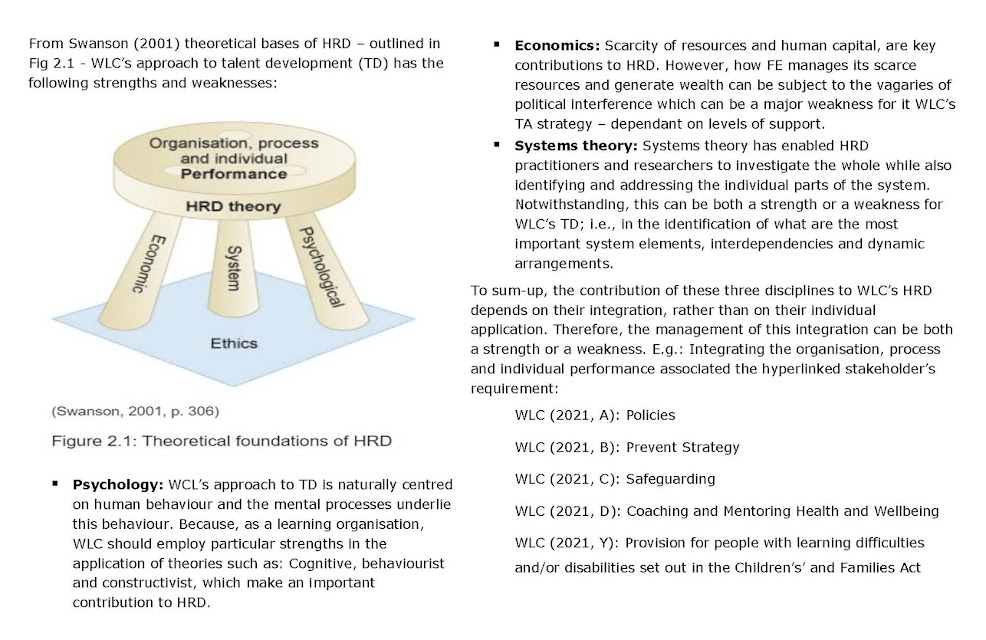For the past decade, I have be working in (Private universities/colleges), which do not particularly support comprehensive talent development. Consequently, the files below are - examples of direct/indirect - evidence of talent development initiatives (TDI), in an Further Education (FE) establishment - I work for approximately 8 years: between February 2008 and January 2017. (Click on) Table 1. to enlarge:

(1): Organisation:
West London College - formally known as EHWLC: (Ealing, Hammersmith and West London College) - is a further and higher education college based across four campuses located in Park Royal, Ealing, Hammersmith and Southall.
The College provides training and development for over 10,000 students from entry level to postgraduate. West London College (WLC) is a member of the Collab Group, which represents 35 of the largest and most innovative colleges in the UK.
"WLC's Vision is to be the leading college in West London for technical and vocational education and skills training. Moreover, their mission and vision are backed up by our the following core values:
- Ambition: To strive to be the best in all areas of strategic importance to the College, enabling their learners, employers and staff to achieve high expectations and ambitious goals.
- Innovation: To be innovative in their thinking, striving to embed new and original practises that will underpin everything they do.
- Accountability: To take personal responsibility for driving success, overcoming barriers and finding solutions. To be constantly learning and developing.
- Inclusion: To be welcoming, supportive and our commitment to equality and diversity which will underpin everything they do." WLC (2021)
As a Business/Maths Lecturer and Tutor, I was primarily involved with: BTEC L3 Extended National Diploma in Business. WLC (2021, E)
(2): Examples of WLC's talent development initiatives
The tools required for successful talent management include workforce planning, recruiting, strategic plan and goal alignment, executive coaching, leadership development, recognition programs, diversity and inclusion, and engagement, as well as retention. Some of WLC's: Direct sources of evidence (DSE) and Indirect sources of evidence (ISE) are illustrated below:
Files:
17-24 - Table 1 - accommodated WLC's: workforce planning, recruiting, strategic plan and goal alignment, DSC and ISE talent development (TL) requirements. In particular, by including the (then) government's educational investment/expansion programme and securing Business Lecturers which had extensive work-experience as well as the necessary academic background - see
File 23: Original job application document.
Files: 1-16 - Table 1 - are examples of how WLC enlisted probationary, appraisals, pay and pension rewards to meet their organisational: goals alignment, recognition programs, diversity and inclusion, and engagement, as well as retention - see File 5: Appraisal (2011) document.
(3): WCL's Talent development strategy
WCL's talent development strategy is not "inclusive", because it is not based on the assumption that anyone has talent; this is born-out by the fact that WCL has made most of its admin-staff redundant and encouraged teaching-staff to take-on these functions. Conversely, WCL's has demonstrated that it has an "exclusive" view that talent is only present in a minority of individuals, because it has laid-off most of its over 50s employees. Notwithstanding, a key-driver behind this action was to reduce the pension commitment to make FE more attractive to the private sector.
WCL's talent development strategy does contain a "broad" view because it considers: workforce and succession planning, recruitment and selection, learning and development, and diversity, which includes flexible working and work–life balance (Taylor, 2014). However, at variance with this, is WLC's "narrow" view, because they are relinquishing their obligation to meet their future skill needs by outsources to recruitment agencies.
WLC talent development strategy does have a blended approach to senior-management roles, but it is less transparent than its overall talent management initiatives. Note: "A ‘blended’ approach is often adopted with regard to the methods, scope and beneficiaries of talent management initiatives. This means that while organisations support all members of the workforce in achieving their full potential, they also have more structured talent management initiatives such as graduate schemes and leadership programmes that are directed specifically at a group of high calibre employees." (Taylor, 2014).
(4): The main strengths and weaknesses of WLC’s approach to talent development.
HRD “encompasses planned activities and processes designed to enhance organisational and individual learning, develop human potential, maximise organisational effectiveness and performance, and help bring about effective and beneficial change within and beyond the boundaries of organisations” B867 Reading 2, (2010, P.206) - Table 1: Hamlin (2004)
Within the wider context of WCL's talent management, talent development has the following aims:
- to complement workforce planning by identifying knowledge, skills and abilities required to meet current and future business needs
- to engage and retain staff (based on the assumption that investment in employee development shows that employees are valued)
However, although WCL's stated "Vision" and "Core-values" - are seen as a strength - by support these aims. WLC's drive to commodify their education provision through outsourcing and rationalisation of age profile of staff - are seen as a short-term weakness - undermine these aims.
WLC's aims to develop learning interventions that are:
- linked to business objectives (to support flexibility in a fast-changing environment)
- smart and efficient (making good use of internal expertise and resources)
- dynamic and constantly reviewed.
Are uncertain, because the commodify of FE provision - Shukr (2017) - has yet to reach market-maturity and consequently, results in strategic gaps. The reasons lock-down and invariable unplanned conversion to the VLE (virtual learning environment) illustrated major weaknesses (IT equipment provision and quality control).

